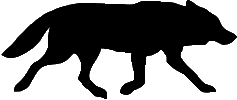Biology
Sociality
The wolf is first and foremost a social animal, in other words, its existence is strictly connected to the ability of interacting with its own kind.
The wolf spends its first life-period alone in search of a partner and of a territory in which it could settle, but most of its existence is based on the pack and family life, within which there is a hierarchical order.
Through its great social skills the wolf has developed the possibility of conveying important notions acquired through experience to the new generations. This happens for example when wolves wean puppies with regurgitation, transmitting to them the interest and familiarity for one food or prey rather than another, or when they change their way of relating to other animals, including to man.
Besides, through its organizational and intuitive skills the wolf can perform much better in predation and interactions with conspecifics. These abilities are important for the survival not only of each individual but, by extension, of the species itself as well.
History
The research today
In our country, various projects aiming at studying both the wolf and the problems related to the cohabitation with man are underway or recently completed, in order to find solutions to them.
Among them, Life Wolfnet in the Majella Park (Abruzzi), starting from the analysis of threats to wolves, aims to develop an integrated model shared by institutions, associations and local population that guarantees the survival of the species by decreasing man-made mortality , dealing with various issues such as the conflict between wolf and animal husbandry, and monitoring wolves with satellite collars.
The Life Medwolf made in the Province of Grosseto has instead the purpose of mitigating the predator’s impact on animal husbandry, and of creating a network of different types of associations, from breeders to environmentalists, to bring out ideas and find solutions that can be shared by all . As part of this project, breeders are given guardian dogs and provided support for their management.
The Life Wolfalps in the Alps (area recently resettled by the wolf and therefore theatre of conflict) aims to share as much as possible information collected by researchers, to carry out coordinated actions regarding the different aspects of management, from the wolf population monitoring to mitigation of livestock damage, from the fight against poaching to the control of stray dogs to prevent hybridization.
The Life MircoLupo on the Tuscan-Emilian Apennines mainly deals with hybridization, carrying out genetic and non-genetic analyzes, to estimate the percentage of hybrids within the wolf population.
One of the innovative actions is the capture, sterilization and release of hybrid specimens: this allows not to eliminate the individual from the pack, which would cause imbalance. But at the same time it stops the propagation of dog’s genetic material among wolves, allowing the hybrids anyway to live in freedom, not held in a cage all life long, also saving on the onerous costs of keeping them in captivity. The specimens released with the satellite collar also provide a lot of information on the behaviour of the hybrids, which seem to be not dissimilar or less elusive than the one of wolves.
Curiosity
Non-invasive genetic techniques
…….we are writing it………
